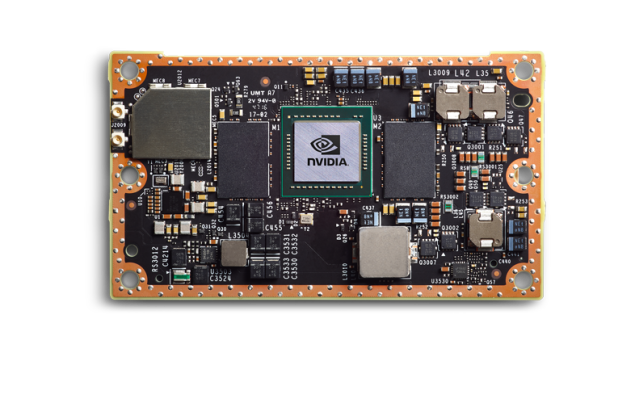Nvidia has a new generation of its Jetson embedded computing platform for devices at the edge of a network, including things like traffic cameras, manufacturing robotics, smart sensors and more. The Jetson TX2 has twice the performance of its predecessor, the TX1, or it can also redirect efficiency to power savings, using less than half the power consumption of the original to achieve the same processing abilities.
The TX2 uses a Pascal-based GPU, as well as two 64-bit Nvidia quad-core ARM chips, with 8GB of RAM on board and 32GB of fast flash storage. It also features built-in 802.11ac Wi-Fi networking, Bluetooth connectivity and 1GB Ethernet for wired connections. It makes it possible to push edge-of-network computing even further, allowing for the running of distributed neural networks right on edge devices that can more accurately do things like identify objects in images, recognize speech or interpret surroundings for autonomous navigation.
Alongside Jetson TX2, Nvidia is also announcing JetPack 3.0, a new version of its AI SDK for the Jetson family, which includes support for TensorRT 1.0, cuDNN 5.1 for deep neural networks, VisionWorks 1.6 for computer vision, as well as all the latest graphics drivers and APIs.
Cisco say that it can use TX2 and Nvidia’s Jetson to add local AI-powered features including face and speech recognition to its Spark enterprise network devices, which could potentially offer a lot of advantages in terms of security and authentication. The TX2 is also set to help students and researchers do a lot more with a lot less investment than you’d typically require for getting started with AI – the developer kit for the new Jetson launches today, with a $599 price tag for preorders in the U.S. and Europe, and a ship date starting March 14.
Nvidia’s shipping TX2 module will retail for $399 when it arrives in Q2, and the existing TX1 and TK1 Jetson embedded computing platforms will also continue to be made available, at reduced prices.
A connected city is also going to have to be an intelligent city, and not just one where the smarts are centrally located in a server facility – each component needs to be somewhat intelligent to help keep things running smoothly throughout the network, without having to worry about infrastructure continuity and latency concerns. Improvements like the generational jump for Jetson TX2 help make that potential future much more achievable.
